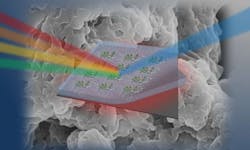Using DNA from salmon, researchers from Yonsei University (Seoul, South Korea) hope to make better biomedical and other photonic devices based on organic thin films, as described in a paper in Optical Materials Express. Often used in cancer treatments and health monitoring, thin films have all the capabilities of silicon-based devices with the possible added advantage of being more compatible with living tissue.
RELATED ARTICLE: DNA acts as a low-cost alignment template for liquid-crystal displays
"DNA is the most abundant organic material, and it is a transparent dielectric, comparable to silica," said Kyunghwan "Ken" Oh, of the Photonic Device Physics Laboratory at Yonsei University. Oh and his colleagues fabricate the thin films in a way that gives them fine control over the material's optical and thermal properties.
As the basis for the silica glass that makes up optical fibers, silicon has long been a dominant material in inorganic photonic devices because it's readily available and easy to work with from the materials perspective. Oh argues that DNA can play the same role in organic photonic devices because it can be found throughout the living world. It could, for instance, be used to make waveguides similar to silica fibers to carry light within the body. Organic devices should also be easy to manufacture, more flexible than silicon and environmentally friendly.
One key property of materials used in photonic devices is the refractive index, which determines how light is directed. An optical fiber requires a core with one index, wrapped in a cladding with a different enough index so that when light hits the interface between core and cladding, it is forced back into the core instead of leaking away. Makers of optical fiber not only need material with two different refractive indexes, they need to control the magnitude of that difference to get the desired effects.
In fine-tuning a method for using DNA to create thin films that could be used in photonic devices, Oh's team was able to get a range of refractive indexes four times greater than that available in silicon. With a greater index difference between core and cladding, they can make much thinner optical fibers, as low as 3 microns in diameter, compared to a minimum of 10 in silicon. This allows for a smaller spot size for the light coming out of the fiber, which could be useful in applications that must carefully target light. "If you have a small target, you should have a sharper arrow," said Oh.
Potential applications could include photodynamic therapy, where a cancer patient is given a drug or other substance that binds to cells in a tumor and light activates the drug and destroys the cancer cells, leaving healthy tissue untouched. The films may also be useful in optogenetics, in which light is used to control the activity of specific brain cells, or to make sensors to measure the pressure or oxygen content of blood pressure that could be worn for a long time without causing irritation because they are organic.
Oh's lab, now that they have discovered methods to fabricate the films and control refractive-index tunability, is also exploring other methods to control the optical properties of DNA. His hope is to develop a set of fundamental principles and processes that will allow manufacturers to build a wide range of optical devices, including a new generation of wearable sensors.
SOURCE: OSA; http://www.osa.org/en-us/about_osa/newsroom/news_releases/2017/dna_the_next_hot_material_in_photonics/
About the Author

Gail Overton
Senior Editor (2004-2020)
Gail has more than 30 years of engineering, marketing, product management, and editorial experience in the photonics and optical communications industry. Before joining the staff at Laser Focus World in 2004, she held many product management and product marketing roles in the fiber-optics industry, most notably at Hughes (El Segundo, CA), GTE Labs (Waltham, MA), Corning (Corning, NY), Photon Kinetics (Beaverton, OR), and Newport Corporation (Irvine, CA). During her marketing career, Gail published articles in WDM Solutions and Sensors magazine and traveled internationally to conduct product and sales training. Gail received her BS degree in physics, with an emphasis in optics, from San Diego State University in San Diego, CA in May 1986.
